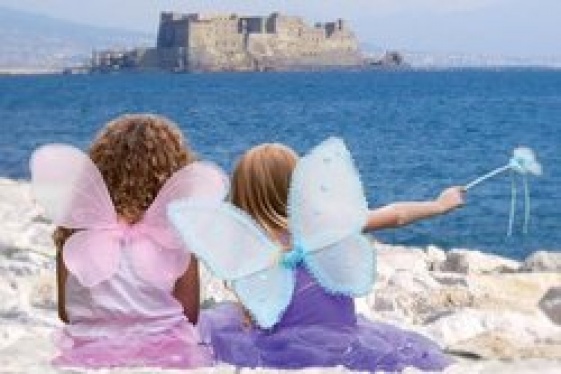

The Royal Palace at Caserta and its park, inserted as one of the 49 Italian UNESCO World Heritage Sites in 1997, are treasures of truly incomparable splendor. Commissioned by Charles III of Bourbon in the 1700s, Luigi Vanvitelli planned this palace, a triumph of the Italian Baroque and one of the most famous and important works by the Neapolitan architect.
Everyday visitors are left enchanted by the beauty of its interiors and by the magnificence of its exterior. Highly-curated and pronounced in the details and design of its four monumental courtyards, the Palace is set amidst a beautiful park that today is the destination of thousands upon thousands of tourists.
The sumptuous palace is an ideal and harmonious fusion of two other royal residences: the Royal Palace at Versailles and the Escorial Palace in Madrid.
The Royal Palace at Caserta spreads out before observers as a monumental complex of 45, 000 s.q.m. (484,376 sq.ft. or approx. 11 acres) and, with its five floors, stands 36 meters (118 feet) tall. On its principal façade are 143 windows, while inside, 1, 200 rooms and 34 stairways unwind throughout the palace. It is constructed mostly in brick while the first two floors are laid with travertine. The entire structure is crowned by a very wide central dome. Those who see its inside are almost always astonished by its continuous succession of stuccoes, reliefs, frescoes, sulptures, flooring and inlays. Those embellishments that stand out the most are located in the Sala di Astrea, Sala di Marte and Sala del Trono; the Sala del Trono, in fact, is the largest of the interior royal apartments – it was used for the reception and accommodation of important personalities of the day.
The most scenographic setting in the Palace is probably where the atrium, the grand Royal Staircase and the chapel meet.
The Royal Staircase is an invention of 17th-Century scenographic arts; it connects the lower and upper vestibules, giving access to the royal apartments via the upper. The Palatine Chapel, designed by Vanvitelli, decorations and all, exhibits - more than any other environment here - strong similarities to the precedents left by Versailles.
Also rather remarkable is the court theatre, a marvelous example of 17th-Century theatre architecture: the horseshoe-shaped hall (as opposed to in the round) is made complete by the particular disposition of the columns (in giant order, or two stories). These are just a few of the environments in the enormous Palace, but all are exceptional.
The Pinacoteca’s (Painting Gallery's) interior is organized as a series of connected room that display countless works of still lifes, war scenes, and of course, portraits of the members of the Bourbon Dynasty.
In the “old apartment” the Bourbon Nativity is always on show. The Nativity Scene was a great passion of the noble Bourbon Family, and it is thanks to them that the Nativity tradition spread from Naples to the rest of the world.
The Palatine Library is annexed to the Queen’s Apartments – woman of refinement and culture – and is decorated by reliefs and frescoes that include that of the zodiac signs and the constellations, executed according to Vanvitelli’s design. Also evocative are the rooms dedicated to the four seasons.
Perhaps the most integral aspect of this Palace’s majesty and beauty is its park, composed of numerous fountains and waterfalls. The park is a typical exemplar of the Italian garden, landscaped with vast fields, flower beds and, above all, a triumph of “water games” or dancing fountains. Along the central axis, then, is a succession of pools, fountains and cascades adorned by large sculptural groupings, all which create a unique scenographic impact that culminates with the Grand Cascade. The park extends to the summit of the hill opposite the Palace, where an English garden perfectly frames an arrangement of exotic plants.
The English Garden, moreover, is very special: wanted by Maria Carolina of Austria, it is less symmetrical in respect to that Italian, but it holds a vast range of indigenous and exotic plants alike, including Cedars of Lebanon.
Together with the Royal Palace and park at Caserta, UNESCO also inserted the Aqueduct (also realized by Luigi Vanvitelli) on the World Heritage List, along with the nearby complex at San Leucio, cited for its representation of a site that is not only an industrial city, but that served as an additional territorial piece of the Royal enclave.
You may be interested
-
'A Ziarella va in America: tournèe in Arizona...
‘A Ziarella va in America. Non è un titolo da film, ma una piacevole realtà. Il...
-
'Iitalian american songbook', il progetto del...
"ITALIAN AMERICAN SONGBOOK", questo il titolo del progetto che ultimamente il pianista d'o...
-
'Lost Child' Wraps Up Ferrante's Neapolitan S...
by Maureen Corrigan If you don't know Elena Ferrante — and judging by conversat...
-
'My dad went to Amalfi...and all I got was a...
by Hunter Davis 'You went to one of the best hotels in the world, in one of the s...
-
'Napoli Napoli' exhibit lets visitors dip int...
The harmony and the refined nature of the ceramics of the Capodimonte Museum alongside San...
-
'Nativity-like scene statues' are unearthed i...
Archaeologists have unearthed 'Nativity-like scene statues' in the ancient ruins of the Ro...
-
'One dead, 10 missing' after torrential rain...
A woman was found dead and around 10 people were still missing on the southern Italian hol...
-
'Paradise inhabited by devils': How Naples ca...
Overlooking sparkling sea and overshadowed by Mount Vesuvius, the Italian city of Naples i...










